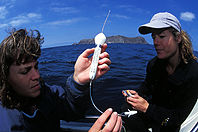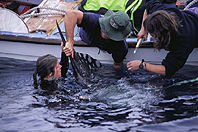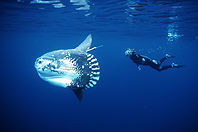






|
|
ONGOING RESEARCHNEW San Diego 2010 Our team is investigating the Molidae through two complementary approaches–pop-off satellite archival tagging of individuals and genetic analysis of global populations. TAGGING Our tagging
work involves special tags called pop-up archival transmitting
(PAT) tags. PAT tags are secured using a plastic anchor inserted
at the posterior base of the dorsal fin. While attached, the tag
records and logs temperature, depth and light intensity. From light
intensity, day length and local noon are calculated. This information
in conjunction with sea surface temperature measurements is used
to document location. After a pre-programmed time, the tag releases
floats to the surface and uploads its data to satellite. Thus,
daily information on movements and behaviors are obtained without
having to relocate either the fish or tag. Should the tag release
early or the fish die and sink, the satellite tag will automatically
surface and initiate transmission. (For more information on satellite
tags see http://www.wildlifecomputers.com/Satellite%20Tags/ Our team has tagged Mola mola off San Diego (California), Capetown (South Africa), Kamogawa (Japan) and Queensland (Australia). We have also tagged Masturus lanceolatus off Hua Lien (Taiwan). To date, six tags have reported and we are in the midst of analyzing our data. We’ll be posting our exciting results soon so stay tuned. The sunfish have some dark secrets to divulge. The mola team
recently returned from a successful tagging trip to Japan where
2 more tags were deployed on Mola mola with the help of the Kamogawa
SeaWorld and the Fisheries Cooperative Association of Kamogawa.
These tags are due to release on Halloween 2003. Whilst over in
Japan, the team also discovered a 1996 record of a Japanese Mola
mola that appears to be a new world record! Check out: http://news.nationalgeographic.com GENETICS Hundreds of tissue samples have been analyzed from mola populations spanning the globe. Some striking differences between certain populations are emerging. We may even have two new species of giant ocean sunfish. So stay tuned on the genetics front as well. COMMERCIAL IMPORTANCE and EDIBILITY While unpopular in Europe and the United States, molas are eaten throughout Asia. Taiwan and Japan are the largest markets. All parts of the mola are eaten including the skin, fin muscles, backbone, testes, and gut which is viewed as a delicacy. In Taiwan, the gut is served as "Dragon Intestines." Unlike their pufferfish relatives, e.g. Fugu, molas do not carry the deadly neurotoxin, tetratrodotoxin (Saito et al 1991). Mola mola is the most common bycatch of the drift net fishery, which targets broadbill swordfish of California and Oregon. According to reports from the National Marine Fisheries Society Southwest Region, between 1990-1998, 26.1% of the drift net catch consisted of the common mola, which translates to a catch of 26,503 individuals. 42.1% of the total discards were mola (Rand Rasmussen, pers comm). In the Spanish driftnet swordfish fishery on the Mediterranean side of the Gibraltar Straits, Mola mola constituted 71% of the entire catch in 1992, 93% in 1993 and 90% in 1994 (Silvani, L. et al, 1999). Until we establish baseline data on these fishes, we have no way of gauging how such capture rates are affecting the wild stock. |
RESEARCH
FUNDING
AND SUPPORT PROVIDED
BY
National
Geographic
Committee
for
Research and Exploration
Taiwan
Fisheries
Research Institute
Smithsonian
Visiting
Research Fellowship
University
of South Florida,
Tampa
Pfleger
Institute of
Marine Science (PIER)
Women’s
International
Science Collaboration
(WISC)
Stephen Drogen
Arcadia Wildlife Preserve, Inc

email: info@oceansunfish.org
oceansunfish.org © 2002 - 2006 Tierney Thys, PhD. All rights Reserved



